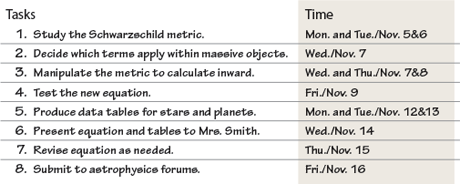Web page: Steven Spielberg, IMDb
Web page: Steven Spielberg, Forbes
Creating is the deepest form of thinking on Bloom’s taxonomy. It results from and calls upon all the other levels. Creation takes many forms, including the following:
acting
arranging
building
composing
dancing
designing
developing
dramatizing
drawing
educating
engineering
experimenting
exploring
founding
gaming
graphing
innovating
modeling
nurturing
organizing
painting
performing
playing
recording
reporting
sculpting
singing
writing
Often, creators combine several of these forms into one project and collaborate with others.
Steven Spielberg has created dozens of films, including Jaws, Schindler’s List, and War Horse. He draws inspiration for his films from other creators, such as musicians and artists. Spielberg has an impressive collection of the artist Norman Rockwell’s work, including one painting of a boy staring in terror over the edge of the high dive. Spielberg says, “Every time I’m ready to make a movie, every time I’m ready to commit to direct a movie, that’s me. That’s the feeling in my gut, before I say ‘yes’ to a picture, because every movie is like looking off a three-meter diving board, every one.” The moral of the story is that creating might seem frightening and messy, even for a seasoned pro like Spielberg, but the best way to create, perhaps, is to just dive in.
In the third part of this book, you’ll find chapters that contain many different kinds of projects: writing, graphing, Web developing, audio-visual, design, performing, and community projects. Though you may create a number of these projects on your own, you will likely work with a group on multipart projects as well. Here’s a high-level plan for an example multipart project.

Your Turn Turn to the project section of this book on pages 429–606 and consider the many project types. Which projects are you most interested in doing? Why?
You may begin creating by simply experimenting. That’s fine. But you can also start with a specific goal in mind. Your goal may be as simple as “write a great song” or as complex as “come up with an equation that extends the Schwarzschild solution within massive nonrotating bodies.” Use the following formula to write a clear goal statement:
Idea | Opportunity | Goal |
Describe gravitational effects within planets and stars. | Use the Schwarzschild solution, which describes effects outside of massive bodies. | I want to use the Schwarzschild solution to create an equation that describes the gravitational effects within stars and planets. |
Your Turn Choose something to create. It can be anything from a school assignment to a cure for cancer. Use the formula above to write a goal statement.
Once you have a goal in mind, you’ll need to carefully consider how to reach it. Answering the 5 W’s and H will help you write objectives.
Who? | I will work with my physics teacher and the equation of Karl Schwarzschild. |
What? | I will create a new equation. |
Where? | The work will happen in physics class and at home. |
When? | I should be done in two weeks. |
Why? | I want to understand the Schwarzschild metric and create and test my own equation. |
How? | I’ll create the equation by studying the metric, learning all its parts, and manipulating them to describe gravity in planets. |
Your Turn Using the goal you wrote above, answer the 5 W’s and H about it in complete sentences. Each of your answers will become an objective.
After setting a goal, you need to figure out how to reach it. Usually, you can’t get there in one giant leap, but you can get there by taking small steps. Make a list of the steps or tasks you must complete to reach your goal. Then, next to each task, indicate when the task should be done.

Your Turn Make a list of tasks and completion times for the goal you established on the previous page.
After establishing your tasks within a time frame, consider the team and tools you’ll need to do the job. Freewrite about them, and then make a list of team members and tools.
I’ll be the main one doing the conversion using my graphing calculator and computer. Mrs. Smith will help me check my work, but I need someone else to help with some of the calculations. John is great with math, so I’ll ask him for help. The people on the astrophysics forums will be able to help, too. I’ve got the Schwarzschild metric, but I need reliable data for the sun and all of the planets.
Team
Me
John
Astrophysics forum
Mrs. Smith
Tools
Schwarzschild metric
Graphing calculator
Computer
NASA Web site
Your Turn Freewrite about the team and tools you will need to reach your goal. Then make a list of team members and tools. Next, decide if you would like to continue your work by completing the project you have planned.
Web page: Steven Spielberg, IMDb
Web page: Steven Spielberg, Forbes
Web page: Is the cure for cancer a virus?
© 2014 Thoughtful Learning
